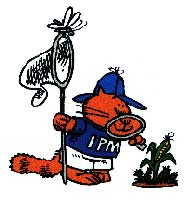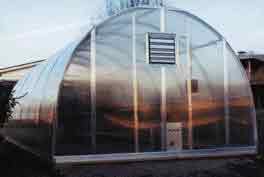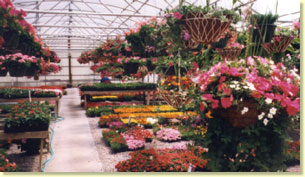Kentucky Pest News Newsletter
HIGHLIGHTS IN THIS ISSUE
Number 1117__________Feb 12, 2007
ANNOUNCEMENTS
CORN
GREENHOUSE
VEGETABLES
DIAGNOSTIC LAB HIGHLIGHTS

ANNOUNCEMENTS
INTEGRATED PEST MANAGEMENT SCHOOL IS MARCH 7
By Patty Lucas
 With higher corn prices driving expectation of producers bringing fallow land back into production, University of Kentucky soil specialists, Greg Schwab and Lloyd Murdock, will discuss bringing this land back into production along with tillage and compaction issues at the College of Agriculture's integrated pest management school Wednesday, March 7 at the UK Research and Education Center in Princeton.
With higher corn prices driving expectation of producers bringing fallow land back into production, University of Kentucky soil specialists, Greg Schwab and Lloyd Murdock, will discuss bringing this land back into production along with tillage and compaction issues at the College of Agriculture's integrated pest management school Wednesday, March 7 at the UK Research and Education Center in Princeton.
The school will also feature an update of soybean rust by Paul Bachi, UK plant diagnostician, along with discussion of the latest in spray technologies available to target soybean rust by Sam McNeill, UK agricultural engineer.
The afternoon session will include a presentation by Ric Bessin, Extension entomologist, on advances in Bt varieties and seed and foliar applied insecticides. Doug Johnson, Extension entomologist, will provide an update on the status of the soybean stem borer and soybean aphid including pesticides available for their control. The afternoon will end with a session on weed identification presented by Jim Martin, UK weeds scientist.
Registration will open at 8:30 a.m. with the meeting starting at 9 a.m. and ending at 4 p.m. The program is free and lunch will be provided. To guarantee a lunch, register by March 1 by calling 270-365-7541, ext. 218 or e-mail plucas@uky.edu.
Program is approved for 5.5 hours of continuing education units for certified crop advisers - 2 in pest management, 1.5 in crop management, and 2 in soil and water management. The meeting will offer 3 General hours and 1 Specific hour of continuing education for Pesticide Safety Education hours for categories 1a, 10 and 12.


CORN
WESTERN BEAN CUTWORM
By Ric Bessin
There's a new corn pest that is moving toward Kentucky. It's called the Western bean cutworm and its moving quickly toward the state from the northwest. Although it's called the western bean cutworm, it doesn't act like a cutworm and it's a serious pest of corn. In some ways it is like the corn earworm in that it attacks the developing ear and kernels. Since this is the part of the plant we market, we consider this a direct pest, one that attacks the part of the plant we sell.
In 2005, the western bean cutworm had spread across Iowa and had entered northwest Illinois. By the end of 2006, it had spread across much of Illinois and the first moths may reach Kentucky by this summer. Trapping for this new pest will begin this summer in Kentucky.
In terms of the life cycle, it overwinters as a larva in the soil and pupates in the spring. The moths begin to emerge in June through early July. Larvae emerge from the eggs laid on the upperside of the leaves and feed on the upper leaves and tassel before moving to the silks and the ear. In the ear, they feed on the developing kernels. Although they are closely related to other cutworms, they don't act like other cutworms in corn. When feeding is complete, the larvae drop to the soil. Fortunately, there is only one generation per year.
With corn earworm, only one larva completes development per ear as the larvae are canabalistic. But this is not the case with the western bean cutworm. There can be one or more feeding on the ear, there are examples of ten in a single ear. Unlike the corn earworm that attacks only the tip of the ear, the western bean cutworm can attack the tip, the side or the butt end of the ear.
One important question is will BT corn control this pest. The answer is that there are differences in performance of the BT corn events for corn borer control. But this is one option for western bean cutworm control.
We do not expect to see any problems from this new pest in 2007 in Kentucky, even if it arrives. It will take a year or more to build in numbers before problems in the field are noticed.
For information about corn pests, visit
"Insect Management Recommendations".


GREENHOUSE
INSV AND TSWV ARE THREATS TO GREENHOUSE ORNAMENTAL PRODUCTION
By John Hartman

Kentucky greenhouse growers are gearing up for production of bedding plants and perennials for spring sale. Production of these transplants may involve propagation of possibly infected overwintering stock or movement of plugs, transplants and sometimes plant diseases long distances. Diseases caused by impatiens necrotic spot virus and tomato spotted wilt virus are important causes of losses in Kentucky greenhouse ornamentals. Although the virus and thrips (the disease vector) are common, growers can avoid crop losses by aggressively controlling thrips and the viruses it spreads. Impatiens Necrotic Spot Virus (INSV) and Tomato Spotted Wilt Virus (TSWV) are two different but closely related viruses causing similar symptoms.
The most common and dramatic problems of greenhouse ornamentals in Kentucky have been due to INSV. This virus is usually the one causing disease symptoms on impatiens, New Guinea impatiens, begonias, petunias snapdragons, cyclamen, cineraria and gloxinia. Both viruses are transmitted from plant to plant by western flower thrips. An adult thrips can infect a plant with virus after feeding for only 30 minutes. TSWV is very damaging to tobacco, tomatoes, and peppers, but it also attacks some ornamentals, most often dahlias imported from overseas, and chrysanthemums and (rarely) ivy geraniums. Both viruses have a very wide host range and both are vectored by western flower thrips.
Virus Disease Symptoms. TSWV/INSV causes a wide variety of symptoms including wilting, stem death, stunting, yellowing, poor flowering; and sunken spots, etches, or ring spots on leaves. Symptoms are not very specific or consistent, and merely tell the grower that there is something wrong with the plant. Many other diseases and plant problems can cause symptoms that resemble TSWV/INSV. Virus symptoms may depend on time of year, type of plant, age of plant, plant physiological state, growing conditions at the time of infection, and strain of virus. In the U.K. Plant Disease Diagnostic Laboratory, positive diagnosis is made by testing infected plant tissue with an ELISA test based on a chemical reaction to the virus proteins. Separate tests are used to look for both TSWV and INSV because a plant may have either or both viruses.
Managing INSV and TSWV in greenhouse ornamentals.
- Inspect incoming plant material for signs of thrips feeding injury, or for symptoms indicative of TSWV or INSV infection. Most plant materials coming from suppliers are not guaranteed to be disease free; thus your inspections are most important. Insist on good thrips control from your plant suppliers.
- Isolate incoming plants from all other plants in the greenhouse until certain they are free of the viruses.
- Separate cutting crops from seedlings. The disease frequently enters the greenhouse within vegetatively propagated plant material. Hanging baskets of infected cutting crops over seedlings can lead to bedding plant losses, since the young seedlings are highly susceptible.
- Immediately discard plants showing distinctive TSWV/INSV symptoms. Early destruction of a few infected plants may prevent an epidemic through all the susceptible plants in the greenhouse. If in doubt, throw them out. Infected plants cannot be cured.
- Do not vegetatively propagate infected plants. The virus can still be maintained in a crop through vegetative propagation even in the absence of western flower thrips.
- Plants may act as reservoirs of the virus. Flowering pot plant crops such as cyclamen can serve to carry the disease over from the fall to the following bedding plant season, as might weeds left under the benches. Eliminate weeds in and near the greenhouse which may harbor thrips and/or the virus.
- Consider using petunia plants as indicators to monitor for TSWV/INSV and thrips feeding injuries; 'Calypso', 'Super Blue Magic' or Summer Madness' petunias may all be used as indicators of TSWV/INSV. Use a yellow (NON-sticky) card to help attract the thrips to the petunias.
- Losses have been greatest with gloxinia, double flowered impatiens, New Guinea impatiens, begonia and cyclamen crops. Be particularly careful to keep these crops isolated from potential sources of virus.
- Be aware that vegetable and tobacco transplants are also susceptible to these viruses and can serve as reservoirs of infection.
o Manage the Western Flower Thrips (Frankliniella occidentalis). See the U.K. Plant Pathology fact sheet, PPFS-GH-2, entitled: Control of Tomato Spotted Wilt Virus and Impatiens Necrotic Spot Virus and Their Vectors, Western Flower Thrips, in Greenhouse Crops.
Perennial plant growers need to aggressively attack TSWV and western flower thrips in both greenhouse and outdoor plantings, and must be aware that plants originating from greenhouse production but now planted outdoors may carry the virus. Even if the thrips do not overwinter in Kentucky, vegetatively propagating infected plants will maintain and spread the virus. Garden center operators must also be aware of the biology of TSWV and western flower thrips, especially if they keep herbaceous plants all year. Many perennials are susceptible to the virus and attractive to thrips. An infected perennial will retain the virus until that plant dies.

VEGETABLES
PRODUCT UPDATES AND LABEL CHANGES FOR 2007 - TOMATOES AND PEPPERS
By Kenny Seebold
Pepper and tomato growers in Kentucky have a number of fungicides and bactericides from which to choose for use in disease management programs. A summary of these options can be found in ID-36 (2006-2007 Vegetable Production Guide for Commercial Growers). A few new products and formulations of old products will be available for this season, however, and are not listed in the most recent version of ID-36.
The following is a summary of new products or formulations labeled for use on tomatoes and peppers, and includes the pre-harvest interval (PHI) and FRAC grouping (code). The FRAC grouping refers to the code assigned by the Fungicide Resistance Action Committee to the active ingredient(s) in a given product. Some of the products in this list have specific modes of action and are thus more at risk for the development of resistance by certain plant pathogens. Fungicides in the same FRAC group share the same mode of action, regardless of the active ingredient. Thus FRAC groupings help can help growers adhere to resistance management guidelines by allowing them to recognize fungicides with the same mode of action and avoid using them in manner that is not consistent with published guidelines. Resistance management guidelines are published by the manufacturers of these products and should be adhered to strictly. As with all pesticides, refer to product labels for specific information on application rates and safe use.
TOMATOES (fresh market and processing)
Aliette WDG (fosetyl-Al 80%) [2.5-5 lb/A] - foliar-applied fungicide for management of root rot (Phytophthora spp.) and damping off (Pythium spp.); field use only. FRAC Group 33; PHI=14 days.
Badge SC (copper hydroxide + copper oxychloride 27%) [1.8-3.7 pt/A] - foliar-applied fungicide/bactericide for management of anthracnose, bacterial speck, bacterial spot, early blight, gray leaf mold, late blight, and Septoria leaf spot; field and greenhouse uses approved. FRAC Group M1; PHI=0 days.
Chloropicrin from Arvesta (chloropicrin 99.5%) [300-500 lb/A] - soil-applied, pre-plant fumigant for management of soilborne diseases and nematodes; field use only. FRAC Group 8b (insecticide); PHI=0 days (product can be applied only prior to seeding or transplanting).
Cuprofix Ultra 40 Disperss DF (basic copper sulfate 71%) [1.25-3 lb/A] - foliar-applied fungicide/bactericide for management of anthracnose, bacterial speck, bacterial spot, early blight, gray leaf mold, late blight, and Septoria leaf spot; field and greenhouse uses approved. FRAC Group M1; PHI=0 days.
Evito 480 SC (fluoxastrobin 48%) [3.8-5.7 fl oz/A] - foliar-applied fungicide for management of early blight, late blight, southern blight, and target spot; field use only. FRAC Group 11; PHI=3 days.
Firewall (streptomycin sulfate 17%) [16 oz per 100 gallons of finished spray] - foliar-applied bactericide for management of bacterial spot; transplant production only. FRAC Group 25; PHI=0 days (cannot be applied after transplanting).
Forum SC (dimethomorph 50%) [6 fl oz/A] - similar to Acrobat 50WP; foliar-applied fungicide for management of late blight; field use only. FRAC Group 40; PHI=4 days.
Kocide 3000 (copper hydroxide 46%) [0.75-1.75 lb/A] - foliar applied fungicide for management of anthracnose, bacterial speck, bacterial spot, early blight, gray leaf mold, late blight, and Septoria leaf spot; field and greenhouse uses approved. FRAC Group M1; PHI=0 days.
Ranman (cyazofamid 40%) [2-2.75 fl oz/A] - foliar-applied fungicide for management of late blight; field use only. FRAC Group 21; PHI=0 days.
Ridomil Gold Bravo SC (mefenoxam + chlorothalonil 44%) [2.5-3.25 pt/A] - foliar-applied fungicide for management of anthracnose, black mold, late blight, fruit rot (buckeye rot), early blight, gray leaf mold, gray leaf spot, Rhizoctonia fruit rot, and Septoria leaf spot; field use only. FRAC Groups 4, M4; PHI=5 days.
PEPPERS (bell, chile)
Badge SC (copper hydroxide + copper oxychloride 27%) [1.8-2.8 pt/A] - foliar-applied fungicide/bactericide for management of anthracnose, bacterial leaf spot, and Cercospora leaf spot; field and greenhouse uses approved. FRAC Group M1; PHI=0 days.
Chloropicrin from Arvesta (chloropicrin 99.5%) [300-500 lb/A] - soil-applied, pre-plant fumigant for management of soilborne diseases and nematodes; field use only. FRAC Group 8b (insecticide); PHI=0 days (product can be applied only prior to seeding or transplanting).
Cuprofix Ultra 40 Disperss DF (basic copper sulfate 71%) [1.25-3 lb/A] - foliar-applied fungicide/bactericide for management of anthracnose, bacterial leaf spot, and Cercospora leaf spot; field and greenhouse uses approved. FRAC Group M1; PHI=0 days.
Evito 480 SC (fluoxastrobin 48%) [3.8-5.7 fl oz/A] - foliar-applied fungicide for management of southern blight; field use only. FRAC Group 11; PHI=3 days.
Firewall (streptomycin sulfate 17%) [16 oz per 100 gallons of finished spray] - foliar-applied bactericide for management of bacterial leaf spot; transplant production only. FRAC Group 25; PHI=0 days (cannot be applied after transplanting).
Forum SC (dimethomorph 50%) [6 fl oz/A] - similar to Acrobat 50WP; foliar-applied fungicide for management of Phytophthora blight; field use only. FRAC Group 40; PHI=4 days.
Kocide 3000 (copper hydroxide 46%) [0.75-1.25 lb/A] - foliar applied fungicide for management of anthracnose, bacterial leaf spot, and Cercospora leaf spot; field and greenhouse uses approved. FRAC Group M1; PHI=0 days.


DIAGNOSTIC LAB HIGHLIGHTS
DIAGNOSTIC LAB - HIGHLIGHTS
By Julie Beale and Paul Bachi
Samples in the PDDL so far this winter have included a number of ornamentals: Phytophthora root rot on
taxus and spruce; black root rot (Thielaviopsis) on pansy and holly; Botrytis blight on pansy; rust
on fuchsia; brown spot needle blight (Mycosphaerella) and pine wilt (nematode) on pine; powdery
mildew on euonymus; Pythium blight on bentgrass. We have also seen symptoms from over-watering,
low light and cold conditions affecting various types of houseplants.
On agronomic, fruit and vegetable crops we have seen gray leaf spot on sorghum; Phytophthora root rot on
grape; cane borer on blackberry; boron deficiency causing hollow stalk and brown bud on broccoli;
and lettuce drop (Sclerotinia) on lettuce.

NOTE: Trade names are used to simplify the information presented in
this newsletter. No endorsement by the Cooperative Extension Service
is intended, nor is criticism implied of similar products that are not
named.
Lee Townsend
Extension Entomologist
BACK
TO KY PEST NEWS HOME
 With higher corn prices driving expectation of producers bringing fallow land back into production, University of Kentucky soil specialists, Greg Schwab and Lloyd Murdock, will discuss bringing this land back into production along with tillage and compaction issues at the College of Agriculture's integrated pest management school Wednesday, March 7 at the UK Research and Education Center in Princeton.
With higher corn prices driving expectation of producers bringing fallow land back into production, University of Kentucky soil specialists, Greg Schwab and Lloyd Murdock, will discuss bringing this land back into production along with tillage and compaction issues at the College of Agriculture's integrated pest management school Wednesday, March 7 at the UK Research and Education Center in Princeton.





